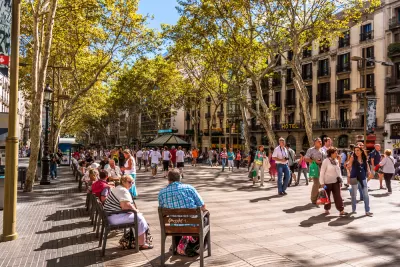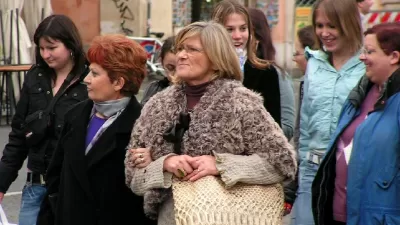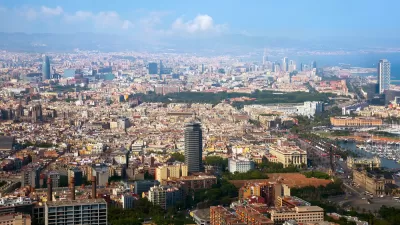Seeking relief from noise, pollution, and incessant traffic, the city of Barcelona has a bold plan to repurpose street space. "Superblocks" will route cars around the perimeter, leaving interior streets open for walkers and bikes.

Like many American cities, Barcelona devotes most of its road space to cars: "Private vehicles account for just 20% of total movements in the city today and yet they occupy 60% of roads." In pursuit of a 21% reduction in traffic, Barcelona's new mobility plan places heavy emphasis on the concept of superilles, or "superblocks." Marta Bausells discusses the ambitious plan in detail.
"In Eixample, a superblock will consist of nine existing blocks of the grid. Car, scooter, lorry and bus traffic will then be restricted to just the roads in the superblock perimeters, and they will only be allowed in the streets in between if they are residents or providing local businesses, and at a greatly reduced speed of 10km/h (typically the speed limit across the city is 50km/h, and 30km/h in specific areas)."
The city will roll out the superblock concept in series of gradual interventions, changing road signs and bus routes while leaving much of the streetscape intact. The superblocks idea has been around since 1987, and the first tests began in Barcelona in 2003. Currently, the idea is already being tested in nine districts via a trial-and-error process that has been called tactical urbanism.
The city hopes to achieve its 21% traffic reduction in two years, along with a corresponding shift to bikes, buses, and pedestrian trips. To get there, 300 km of new bike lanes are in the works.
FULL STORY: Superblocks to the rescue: Barcelona’s plan to give streets back to residents

Study: Maui’s Plan to Convert Vacation Rentals to Long-Term Housing Could Cause Nearly $1 Billion Economic Loss
The plan would reduce visitor accommodation by 25,% resulting in 1,900 jobs lost.

North Texas Transit Leaders Tout Benefits of TOD for Growing Region
At a summit focused on transit-oriented development, policymakers discussed how North Texas’ expanded light rail system can serve as a tool for economic growth.

Why Should We Subsidize Public Transportation?
Many public transit agencies face financial stress due to rising costs, declining fare revenue, and declining subsidies. Transit advocates must provide a strong business case for increasing public transit funding.

How to Make US Trains Faster
Changes to boarding platforms and a switch to electric trains could improve U.S. passenger rail service without the added cost of high-speed rail.

Columbia’s Revitalized ‘Loop’ Is a Hub for Local Entrepreneurs
A focus on small businesses is helping a commercial corridor in Columbia, Missouri thrive.

Invasive Insect Threatens Minnesota’s Ash Forests
The Emerald Ash Borer is a rapidly spreading invasive pest threatening Minnesota’s ash trees, and homeowners are encouraged to plant diverse replacement species, avoid moving ash firewood, and monitor for signs of infestation.
Urban Design for Planners 1: Software Tools
This six-course series explores essential urban design concepts using open source software and equips planners with the tools they need to participate fully in the urban design process.
Planning for Universal Design
Learn the tools for implementing Universal Design in planning regulations.
City of Santa Clarita
Ascent Environmental
Institute for Housing and Urban Development Studies (IHS)
City of Grandview
Harvard GSD Executive Education
Toledo-Lucas County Plan Commissions
Salt Lake City
NYU Wagner Graduate School of Public Service





























